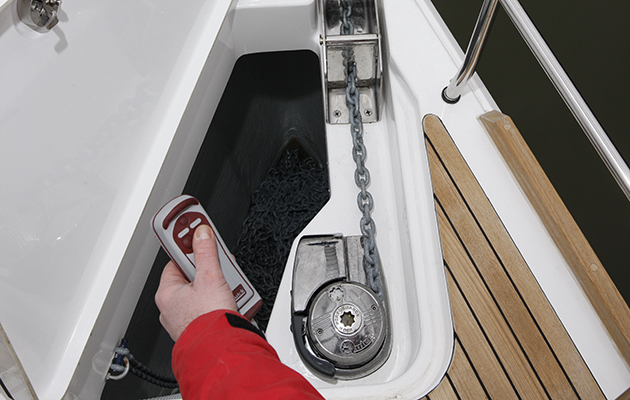From batteries to logs, Rupert Holmes reminds us of the quick checks with long-lasting implications
When preparing a boat for the season the tendency is to focus on big or obvious items, many of which take place with the boat out of commission, or even ashore.
These include tasks like antifouling, replacing anodes, polishing the hull and so on.
Equally, if they were not carried out in the autumn, servicing the engine, winches and valeting sails would also be on the list.
However, there’s a host of other jobs that are easily forgotten, particularly given boats are becoming more complex, some of which have the potential to spoil a weekend, or even to interrupt a summer cruise.
Here are eight key jobs, each of which is easy to carry out, that will make a boat safer and more reliable.
1. Calibrate your battery monitor

These can be great tools when properly set up, but have the potential to produce misleading information.
A key problem is the decline of a battery bank’s capacity over time – if the monitor is not recalibrated to reflect this it will display an overly optimistic assessment of the state of charge.
Therefore, as a minimum it makes sense to recalibrate, as per the device’s manual, at the start of each season.
Alternatively consider fitting a newer more sophisticated model, such as the Balmar SG200, that’s self-calibrating.
In this case it also calculates the bank’s ‘state of health’ – the measured capacity of the batteries expressed as a percentage of their original rated capacity.
2. Check the rig tune
I’m often amazed by the number of cruising yachts with worryingly slack standing rigging.
If the shrouds on the lee side – particularly the caps – are loose with less than 20 degrees of heel, they need additional tension.
This is particularly important for yachts with aft-swept spreaders.
If the rig was lowered over the winter it’s worth being sure that both you and the boatyard have the same expectations when it’s replaced in the spring.
If you’re invoiced only for stepping the rig there’s a good chance the standing rigging has been tensioned only enough to support the mast with the boat on its mooring.
It’s not that easy for cruising sailors to check their rig tension themselves, until you can see if the rigging is slack on the first sail of the season.
The Selden rig guide does describe a method of setting the rig up from scratch using a 2m-long folding rule and vernier callipers, but it’s a bit laborious as you start by slackening everything right off –and you still have to sail to check it’s right.
3. What’s lurking in the fuel tank?

While it’s good practice to keep tanks topped up, especially during the winter, to minimise bacterial growth, this alone cannot give total peace of mind.
However, taking a sample of the fuel at the lowest corner of the tank will help give some reassurance.
If you’re lucky there will be a drain tap here, enabling you to drain off half a pint of fluid into a suitable container to examine its contents.
With any luck, it will prove clear of contaminants.
If not, this arrangement generally allows you continue running the crud out of the tank until clear fuel emerges.
If there’s no drain tap there may be a dipstick, or other access point, deliberately located above the lowest part of the tank.
You can then use a hand pump to extract a sample of fuel.
Again, keep extracting liquid until there’s only neat diesel left. Don’t despair if you can’t access the tank this way.
The chances are it will have some kind of inspection cover or other aperture through which an extended intake hose from a pump can be inserted and manoeuvred to the bottom of the tank.
You can buy fuel testing kits for fuel bug, but a simple visual inspection of the fuel from the bottom of the tank will tell you most of what you need to know.
4. Operate all the electrics
If frequently used items are working as they should, human nature is such that it’s easy to assume all the boat’s electrics are in good order.
However, when thinking rationally we all know that the only way to be sure is through a thorough check.
A quick check at this time of year will help prevent a last-minute rush to fix issues at the start of an early-season cruise.
Connections for navigation lights, wind instrument sensors and tiller pilots are particularly prone to problems developing over the winter.
Equally, freshwater pumps may suffer from frost damage.
5. Don’t forget the windlass!

Few pieces of equipment operate in a harsher environment than windlasses.
In many cases they are used sporadically for a summer cruise, dowsed with salt water on the passage home and then given next to no maintenance for months afterwards.
Checking its operation now will reduce the chances of a disappointing surprise later.
Give it a wash down, then remove the gypsy and grease the drum.
Check that it rotates as it should, the brake works, and that there isn’t any evidence of corrosion around any electrical contacts, before smearing them with some petroleum jelly.
Inspect generators and spare autopilot rams too.
Along with windlasses, these items are the most common to be found to be defunct on used yachts for sale.
6. Update navigation resources

Make sure you chart software is up to date before you go sailing. Credit: Graham Snook/YM
These days we use a plethora of navigation sources, including chartplotters, iPads, smartphones and paper charts.
If anything, this can make it harder to keep everything up to date than it was back in the days that a set of Admiralty Notices to Mariners – and a few spare evenings – was all that was needed to keep a portfolio of paper charts up to date.
However, the imperative to navigate with the best data remains just as important.
Even if it’s not practical to update every source on board, it’s still worth ensuring that one source of navigational info is bang up to date and that the others don’t have obvious major deficiencies.
Depending on what kind of chart software you have, updates are usually downloadable, either automatically or manually, from the supplier’s website, and can then be transferred to the chart chip or direct to the chartplotter.
For phone apps, make sure your subscription is up to date and covers the areas you’ll be sailing in.
7. Double check safety gear

Credit: Graham Snook/YM
The best way for everyone on board to be fully conversant with safety equipment is to handle it frequently.
This is also a habit that stands to uncover any accidental omissions in servicing or replacing items such as EPRIBs, flares, liferafts and personal AIS units.
In addition to annual servicing, lifejackets should be inspected for visual damage and to confirm the inflation bottle is screwed tightly in place each time they are worn.
The latter is particularly important – it’s easy for the CO2 bottle to rotate enough to expel the gas into the atmosphere, rather than the lifejacket’s bladder.
For a more detailed inspection and service, most manufacturers will be able to do this, or the RNLI can provide a detailed lifejacket check.
8. Start a maintenance log
Modern yachts are far more complex than their forebears.
This is even true for older models which, like Victorian houses, have been refitted and equipped to a standard that would be unrecognisable to their original owners.
This complexity, however, makes it hard to keep track of exactly when each task was last attended to.
If you don’t already have one, a maintenance log should tell you for instance exactly when the lifejackets were last checked, when the windlass was last serviced and when the cooling water impeller was last replaced.
It’s a good way of keeping track of every maintenance task on board from anode changes to sail servicing, and engine servicing to replacing expired flares.
There are now some websites and apps, such as the GJW MyBoat website, that will help you do this and remind you when a task becomes due.
Free RNLI safety check

The RNLI regularly runs lifejacket clinics. Credit: RNLI Fowey
Trained RNLI volunteers can offer advice on safety: For free, independent advice on safety, take advantage of the RNLI’s ‘Advice Onboard’.

Rupert Holmes has sailed over 80,000 miles, including from New Zealand to Uruguay via Cape Horn and racing around Britain
Highly-trained volunteers will visit you on your boat to offer suggestions on how to improve safety and equipment.
They’ll work through from stem to stern, answering questions and giving you a summary of the main points to take away.
The RNLI also runs free lifejacket clinics, where you can check your lifejackets for wear and tear and learn simple maintenance.
At a recent clinic 80% of lifejackets had faults!
Register your interest or book online at: rnli.org/safety/what-we-can-do-for-you
For all the latest from the sailing world, follow our social media channels Facebook, Twitter and Instagram.
Have you thought about taking out a subscription to Yachting Monthly magazine?
Subscriptions are available in both print and digital editions through our official online shop Magazines Direct and all postage and delivery costs are included.
- Yachting Monthly is packed with all the information you need to help you get the most from your time on the water.
- Take your seamanship to the next level with tips, advice and skills from our expert skippers and sailors
- Impartial in-depth reviews of the latest yachts and equipment will ensure you buy the best whatever your budget
- If you are looking to cruise away with friends Yachting Monthly will give you plenty of ideas of where to sail and anchor




